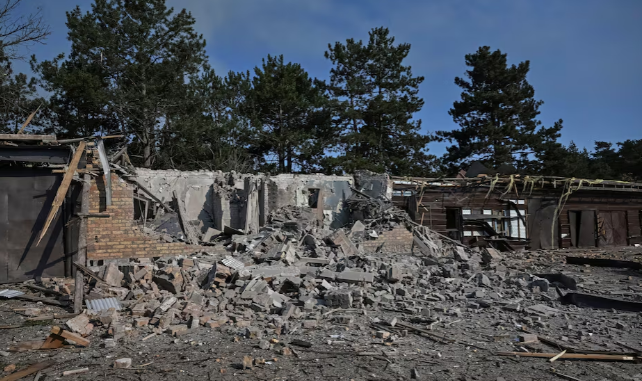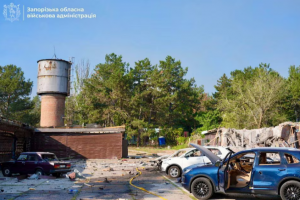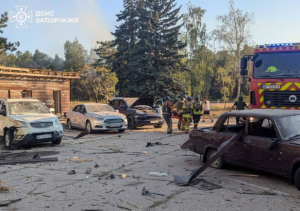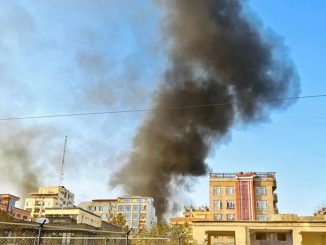
A view shows the site of a Russian military strike, amid Russia’s attack on Ukraine, in Zaporizhzhia region, Ukraine August 6, 2025. REUTERS/Stringer Purchase Licensing Rights
| Published August 7, 2025
KYIV, UKRAINE — Ukraine’s military command reported a staggering surge in Russian aggression this week, claiming that Moscow’s forces launched more than 500 attacks across various fronts in a single 24-hour period. The claim, which underscores the grinding intensity of the ongoing war, paints a grim picture of a conflict that continues to escalate even as global attention wavers.
The General Staff of the Armed Forces of Ukraine said on Wednesday that Russian forces deployed a combination of artillery barrages, drone strikes, missile launches, and aerial bombings from the eastern Donbas region to the southern front lines in Zaporizhzhia and Kherson. Ukrainian officials characterized the attacks as part of a “scorched-earth” strategy aimed at exhausting defenders and destabilizing civilian infrastructure.
“This is not just a military operation; this is psychological warfare, economic sabotage, and an all-out attempt to crush Ukrainian resolve,” said Colonel Oleksandr Shtupun, a spokesperson for Ukraine’s southern operational command.
A Day of Devastation
While many of the 500-plus attacks targeted defensive positions, several were aimed at civilian-populated zones. Local authorities in Kharkiv, Dnipro, and Mykolaiv reported multiple injuries and at least eight civilian deaths resulting from overnight strikes, including drone-launched explosives hitting residential buildings and energy facilities.
In Odesa, critical port infrastructure was once again targeted by Russian cruise missiles. Ukrainian forces said they successfully intercepted several incoming threats using Western-supplied air defense systems, but admitted some damage was unavoidable.
“Each missile we intercept saves lives, but each one that gets through reminds us that this war is far from over,” said Air Force spokesman Yuriy Ihnat.
A War of Attrition
Analysts say the frequency and scale of Russian attacks are part of a broader strategy to wear down Ukrainian defenses and test NATO’s commitment amid growing signs of “war fatigue” in the West. The Institute for the Study of War noted that the recent uptick in strikes may reflect an attempt by the Kremlin to regain momentum as Ukraine struggles with ammunition shortages and a delayed counteroffensive.
Meanwhile, Ukrainian President Volodymyr Zelenskyy renewed calls for more advanced weaponry and accelerated aid deliveries from allied nations. In a televised address, he warned that the surge in attacks could be a precursor to a broader offensive.
“Russia is not slowing down. Every hour, every missile, every drone is aimed at our sovereignty. The world must respond not with hesitation, but with unity and speed,” Zelenskyy said.
Civilian Resilience and Growing Fatigue
Despite the heavy toll, the Ukrainian population continues to show signs of resilience. In cities under constant threat, volunteers distribute food, repair damaged buildings, and organize underground schooling for children. However, mental health experts and humanitarian organizations report rising levels of trauma, burnout, and displacement.
More than 100,000 people have fled frontline communities in the past month alone, according to the United Nations, which warns of a “growing humanitarian crisis” as winter approaches and power grids remain vulnerable.
Global Reactions and What Comes Next
The international response has been measured but concerned. NATO Secretary General Jens Stoltenberg condemned the Russian escalation, calling it “a blatant disregard for human life and international law.” The U.S. State Department pledged additional aid but stopped short of announcing new military commitments.
For many in Ukraine, such statements are welcome but not enough.
“Words won’t stop the missiles. We need action, and we need it now,” said 35-year-old Larysa, a schoolteacher in Zaporizhzhia whose home was damaged in a recent drone strike.
As the war grinds on into its third year, the figure of 500 attacks in just 24 hours serves as a chilling reminder that while diplomacy may stall, the battlefield remains tragically active.

A view shows the site of a Russian military strike, amid Russia’s attack on Ukraine, in Zaporizhzhia, Ukraine August 6, 2025. Zaporizhzhia Regional Military Administration via Telegram/Handout via REUTERS Purchase Licensing Rights

Rescuers evacuate a wounded resident at the site of a Russian military strike, amid Russia’s attack on Ukraine, in Zaporizhzhia region, Ukraine August 6, 2025. Press service of the State Emergency Service of Ukraine in Odesa region/Handout via REUTERS Purchase Licensing Rights
 Implications:
Implications:
Here are the implications of the report that Kyiv claims Moscow carried out over 500 attacks in 24 hours, broken down into key areas:
🛡️ Military Implications
-
Escalation of hostilities: A surge in attacks suggests Russia may be preparing for a larger offensive or testing Ukraine’s defense limits.
-
Ukrainian resource strain: High-frequency attacks deplete ammunition, air defense systems, and manpower, putting pressure on Ukraine’s ability to hold the line.
-
Adaptation of tactics: Ukraine may be forced to change strategy—shifting from counteroffensive posture to defensive consolidation.
🇺🇦 Political Implications
-
Renewed calls for aid: Kyiv will likely use this development to push Western allies for faster and more substantial military support.
-
Increased wartime unity: Domestically, the Ukrainian government may see a rally-around-the-flag effect, strengthening national resolve.
-
Diplomatic pressure on Russia: The international community could use this data to justify further sanctions or condemnations.
🌍 Geopolitical Implications
-
Testing NATO’s patience: The scale of attacks could be seen as Russia probing the West’s limits—will allies stay committed, or back off due to “war fatigue”?
-
China and Global South watching: Non-aligned nations might reassess their positions based on whether the West responds with action or restraint.
-
Potential for spillover: Escalation raises the risk of conflict spilling beyond Ukraine’s borders—whether via refugee waves, cyberattacks, or military accidents.
🧍♂️ Humanitarian Implications
-
Rising civilian toll: Increased attacks mean more civilian deaths, injuries, and displacement, worsening the refugee and housing crises.
-
Mental health crisis: The constant bombardment, fear, and instability are fueling long-term psychological trauma among Ukrainians.
-
Aid bottlenecks: Damage to infrastructure could limit the ability of humanitarian organizations to reach affected communities.
⚡ Infrastructure and Economic Implications
-
Energy system under threat: Strikes on power grids may lead to rolling blackouts, particularly dangerous as colder months approach.
-
Economic slowdown: Industrial and agricultural output in frontline regions is disrupted, hurting Ukraine’s economy and global food supply chains.
-
Reconstruction costs rising: Every new attack increases the long-term burden of rebuilding Ukraine post-war.
 Overall Takeaway:
Overall Takeaway:
The claim that Moscow launched over 500 attacks in just 24 hours is more than a statistic—it’s a stark reflection of a war that shows no signs of slowing down. For Ukraine, it signals another grueling chapter in a conflict defined by endurance and sacrifice. For the international community, it serves as a wake-up call: this war is not frozen, and the cost of complacency could be catastrophic. As missiles rain down and civilians brace for impact, the world must decide—will it respond with urgency, or let fatigue and distraction pave the way for further devastation?





Be the first to comment